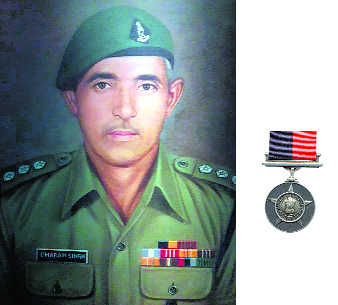This 5 Jat Hony Capt kept Chinese at bay for 3 days
Col Dilbag Dabas (Retd)
The myth ‘Hindi-Chini bhai bhai’ went for a toss in the morning hours of October 10, 1962, when Chinese Infantry Regiment (equivalent to Indian brigade of three battalions) rolled down south of Thagla La ridge in Kameng division of North East Frontier Agency (NEFA) and attacked the Indian Army holding hastily prepared defences on the south bank of the Nam Ka Chu river. The troops holding the defences were never so ill-equipped, ill-clothed and ill-acclimatised to fight at heights ranging from 15,000 feet to 20,000 feet in an extreme cold climate. To minimise the drastic fallouts of the decisions taken at the highest level, the Army was not even made to fight for an effect. While withdrawal is also an operation of war, during 1962, most of the times, it was resorted to based on decisions, which defied military logic.
Dharam Singh, son of Bharat Singh, was born at Gubhana Mazri village in present day Jhajjar district. After primary education from High School in Badli block, he was enrolled in 5th Battalion of Jat Regiment in May 1953.
During the 1962 war with China in the western sector (read Ladakh) to give depth to the strategically important Daulat Beg Oldi (DBO), 14 Jammu and Kashmir Militia Battalion and ‘C’ Company of 5th Jat Battalion were deployed about seven miles north-east of the DBO; the Militia from lower reaches of Point 20140 (the general height at which the Militia and the Jats were deployed) in the east to the track junction leading to Karakoram Pass on the west and ‘C’ Company of 5 Jat occupying defences on the posts of Bhanu, Arni 1 and Arni 2, east of Jammu and Kashmir Militia. By the morning of October 20, the Chinese had isolated the Arni 1 and Arni 2 posts held by the Jats and were preparing for an attack on both posts simultaneously. It was while defending the Arni 2 post that Havildar Dharam Singh of 5th Jat Battalion exhibited his mettle. For his presence of mind, novel tactics, dogged determination and inspirational junior leadership, Havildar Dharam Singh was awarded the Vir Chakra. The battle account is available in the War Diary of 5th Jat Battalion.
Dharam Singh retired as Honorary Captain in 1981 after having participated in the 1962 war with China as well as in the 1965 and 1971 wars with Pakistan. He dedicates his Vir Chakra to his comrades who fell in the battle for which he was awarded the medal. Asked about his experience during the 1962 war, the octogenarian Honorary Captain replied with a sigh, “Ladai kahan hui sahab. Jitney gernail the, teen din ki ladai mein sabke saans phool gaye, aur order aane lage, withdraw ho jao, withdraw ho jao”. He spoke further with anguish, “Hamare paas itna ammunition tha ki ek mahene tak Chinion ko rok sakte thhe lekin……..”
A lot has been written about the 1962 war with China, some still remains classified but it continues to be one of our least understood historical events. Shiv Kunal Verma, a military historian of repute, rightly refers to the 1962 war as an unmitigated disaster in his book, aptly titled “1962, the war that wasn’t”. Hony Capt Dharam Singh is a living testimony to the fact that men and officers, who tried to take a stand during the 1962 debacle, were let down by their political and military superiors.
The battle account in war Diary of 5th Jat Battalion reads...
On October 20, 1962, Havildar Dharam Singh was the post commander at Arni 2, holding it by a section of 10 men covering a frontage of 300 yards when the Chinese subjected it to heavy machine gun and mortar fire before the attack. To deceive the enemy forming up in superior strength, Dharam Singh employed a novel method. Leaving two men with a light machine gun to fire intermittently at the enemy, he positioned others on a flank and returned the fire. This adjustment gave an impression of a bigger number at the post. He kept on shifting his men between the two positions and kept the enemy at bay for three days. Though seriously injured in a leg by enemy mortar splinter, during those three days, he moved from one position to the other, inspiring his men to hold fast and not give up. After three days of determined stand by the Jats, Havildar Dharam Singh was ordered to abandon the post and withdraw with his section to the DBO. The bold and determined action by Havildar Dharam Singh was in the highest traditions of the Regiment which helped the defence of the posts further south
(The writer is a veteran Gunner, 6 Field Regiment)









